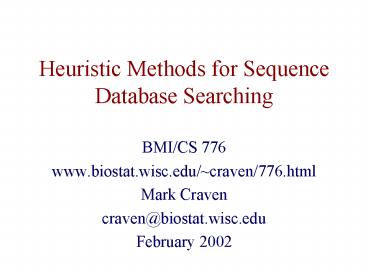Heuristic Methods for Sequence Database Searching PowerPoint PPT Presentation
1 / 23
Title: Heuristic Methods for Sequence Database Searching
1
Heuristic Methods for Sequence Database Searching
- BMI/CS 776
- www.biostat.wisc.edu/craven/776.html
- Mark Craven
- craven_at_biostat.wisc.edu
- February 2002
2
Announcements
- bioinformatics talk tomorrow
- Computation in the Imaging of Large Molecules
- Prof. George Phillips
- 2/7, 400pm in Computer Sciences 1325
- to get on a mailing list of UW bioinformatics
events http//gacrux.biostat.wisc.edu/mailman/lis
tinfo/bioinformatics - reading for next week
- Delcher et al., Alignment of Whole Genomes
3
Heuristic Alignment Motivation
- too slow for large databases with
high query traffic - heuristic methods do fast approximation to
dynamic programming - FASTA Pearson Lipman, 1988
- BLAST Altschul et al., 1990
4
Heuristic Alignment Motivation
- consider the task of searching SWISS-PROT against
a query sequence - say our query sequence is 362 amino-acids long
- SWISS-PROT release 38 contains 29,085,265 amino
acids - finding local alignments via dynamic programming
would entail matrix operations - many servers handle thousands of such queries a
day (NCBI gt 50,000)
5
BLAST Overview
- Basic Local Alignment Search Tool
- BLAST heuristically finds high scoring segment
pairs (HSPs) - identical length segments from 2 sequences with
statistically significant match scores - i.e. ungapped local alignments
- key tradeoff sensitivity vs. speed
6
BLAST Overview
- given query sequence q, word length w, word
score threshold T, segment score threshold S - compile a list of words that score at least T
when compared to words from q - scan database for matches to words in list
- extend all matches to seek high-scoring segment
pairs - return segment pairs scoring at least S
7
Determining Query Words
- Given
- query sequence QLNFSAGW
- word length w 2 (typically w 3 or 4)
- word score threshold T 8
- Step 1 determine all words of length w
- in query sequence
- QL LN NF FS SA AG GW
8
Determining Query Words
- Step 2 determine all words that score at least T
when compared to a word in the query sequence - QL QL11, QM9, HL8, ZL9
- LN LN9, LB8
- NF NF12, AF8, NY8, DF10,
- SA none
- ...
words from sequence
query words w/ T8
9
Scanning the Database
- search database for all occurrences of query
words - approach
- build a DFA that recognizes all query words
- run DB sequences through DFA
- remember hits
10
Scanning the Database
- use Mealy paradigm (accept on transitions) to
save space and time - consider a DFA to recognize the query words QL,
QM, ZL
accept on red transitions
11
Extending Hits
- extend hits in both directions (without allowing
gaps) - terminate extension in one direction when score
falls certain distance below best score for
shorter extensions
- return segment pairs scoring at least S
12
Sensitivity vs. Running Time
- the main parameter controlling the sensitivity
vs. running-time trade-off is T (threshold for
what becomes a query word) - small T greater sensitivity, more hits to expand
- large T lower sensitivity, fewer hits to expand
13
BLAST Notes
- may fail to find all HSPs
- may miss seeds if T is too stringent
- extension is greedy
- empirically, 10 to 50 times faster than
Smith-Waterman - large impact
- NCBIs BLAST server handles more than 50,000
queries a day - most used bioinformatics program
14
More Recent BLAST Extensions
- the two-hit method
- gapped BLAST
- PSI-BLAST
- all are aimed at increasing sensitivity while
limiting run-time - Altschul et al., Nucleic Acids Research 1997
15
The Two-Hit Method
- extension step typically accounts for 90 of
BLASTs execution time - key idea do extension only when there are two
hits on the same diagonal within distance A of
each other - to maintain sensitivity, lower T parameter
- more single hits found
- but only small fraction have associated 2nd hit
16
The Two-Hit Method
hits w/T gt 10
extend these cases
hits w/T gt 12
Figure from Altschul et al. Nucleic Acids
Research 25, 1997
17
Gapped BLAST
- trigger gapped alignment if two-hit extension has
a sufficiently high score - find length-11 segment with highest score use
central pair in this segment as seed - run DP process both forward backward from seed
- prune cells when local alignment score falls a
certain distance below best score yet
18
Gapped BLAST
seed
Figure from Altschul et al. Nucleic Acids
Research 25, 1997
19
PSI (Position Specific Iterated) BLAST
- basic idea
- use results from BLAST query to construct a
profile matrix - search database with profile instead of query
sequence - iterate
20
A Profile Matrix
sequence positions
-2.4
1.2
amino acids
0.5
-0.2
-3.1
21
PSI BLASTSearching with a Profile
- aligning profile matrix to a simple sequence
- like aligning two sequences
- except score for aligning a character with a
matrix position is given by the matrix itself
not a substitution matrix
22
PSI BLASTConstructing the Profile Matrix
query sequence
these sequences contribute to the matrix at
position 108
Figure from Altschul et al. Nucleic Acids
Research 25, 1997
23
PSI BLASTDetermining Profile Elements
- the value for a given element of the profile
matrix is given by
- where the probability of seeing amino acid
in column j is estimated as
observed frequency
pseudocount

